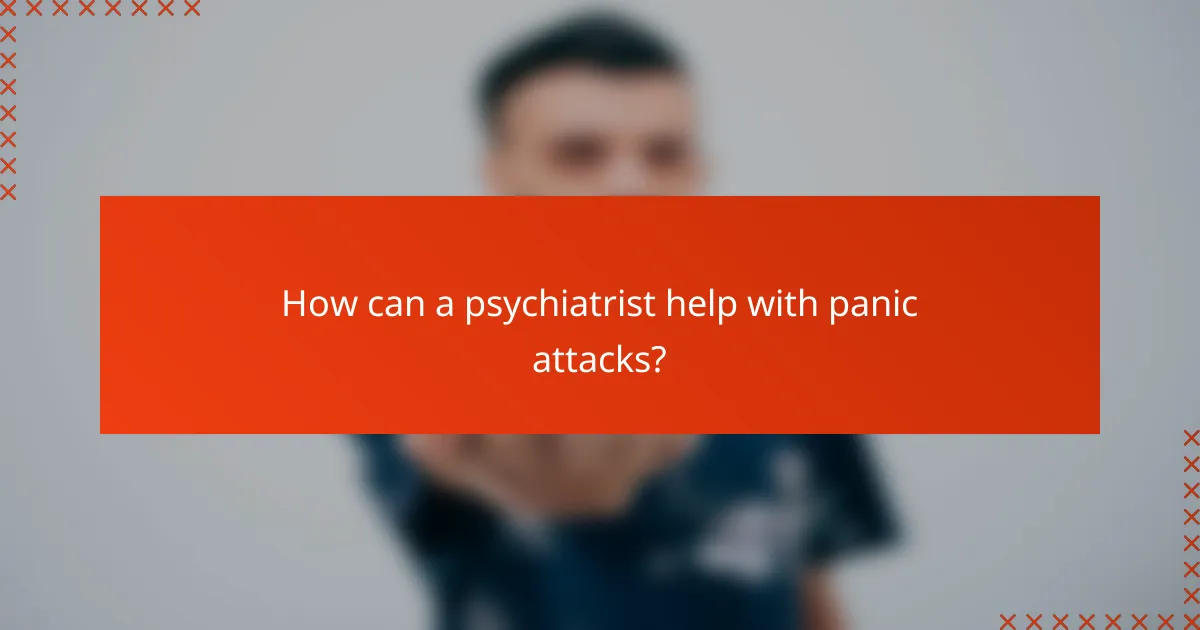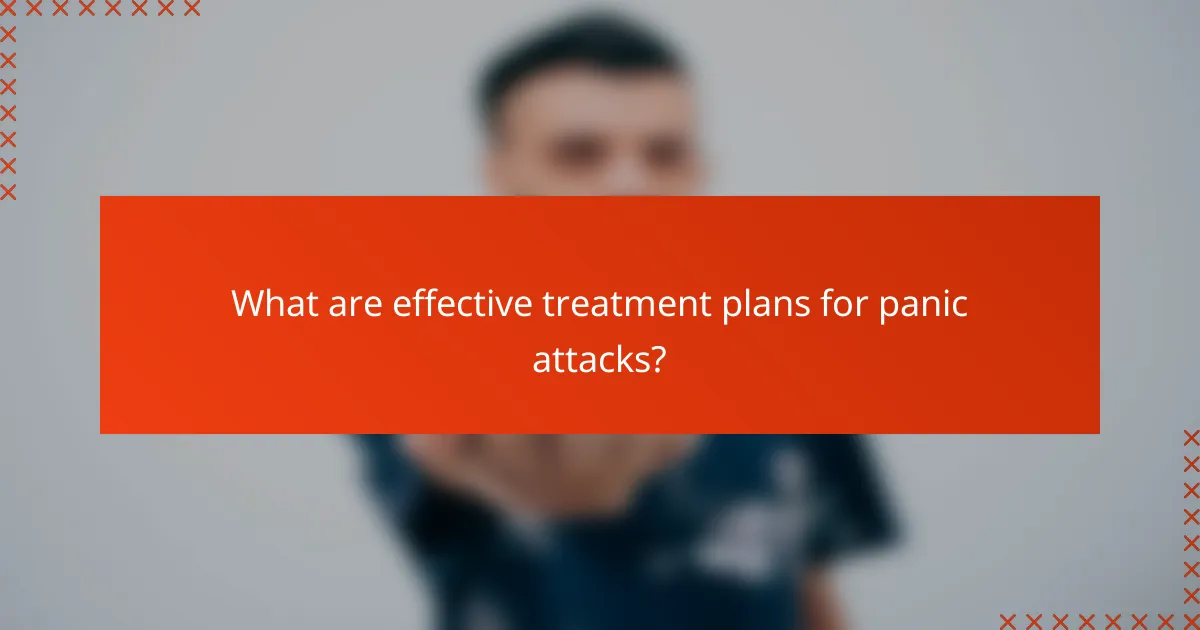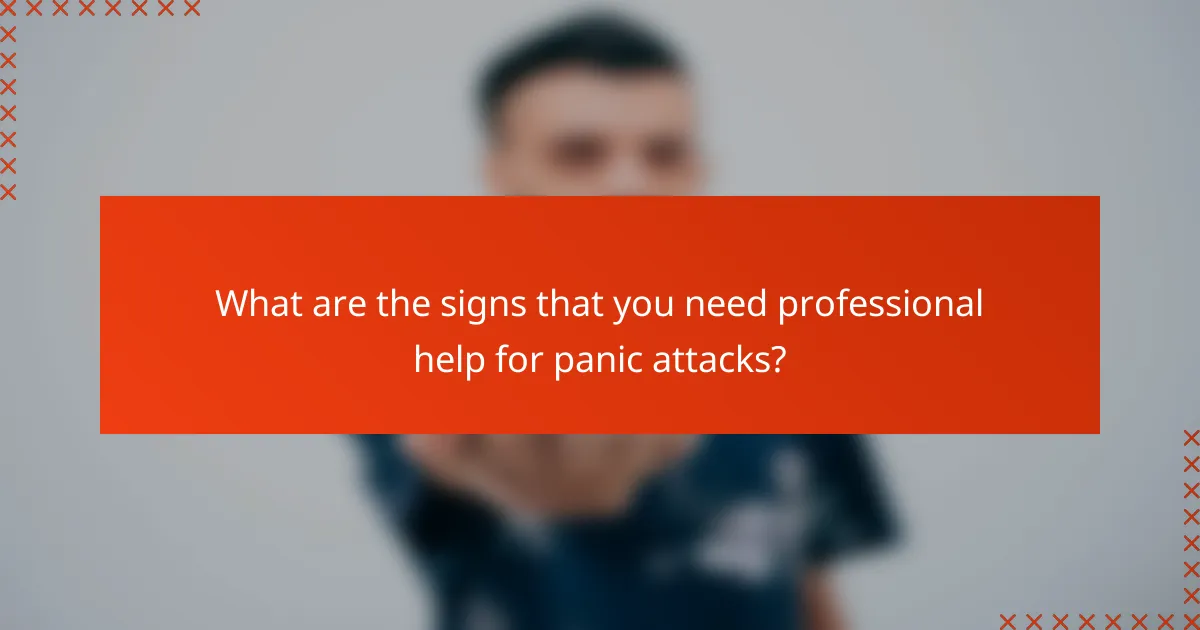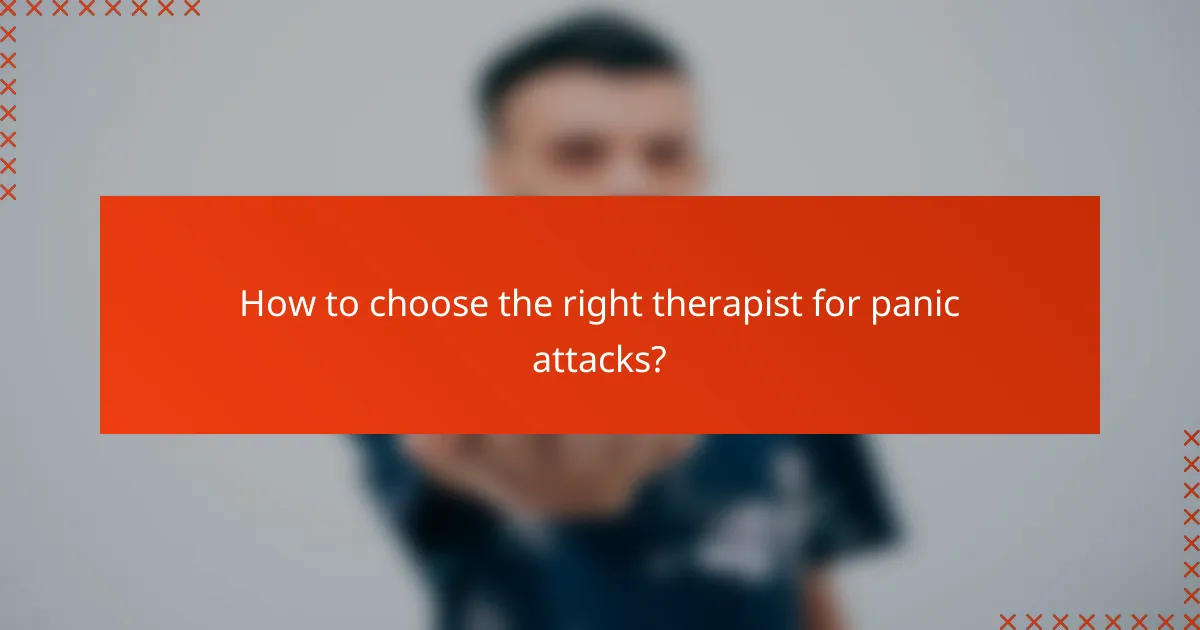Panic attacks can be overwhelming, but various professional help options are available to manage and alleviate symptoms. In the UK, individuals can explore therapies such as Cognitive Behavioral Therapy and Exposure Therapy, while psychiatrists offer medication and tailored treatment plans. Combining these approaches can lead to effective management and improved coping strategies for those affected.

What therapy options are available for panic attacks in the UK?
In the UK, several effective therapy options are available for managing panic attacks, including Cognitive Behavioral Therapy (CBT), Exposure Therapy, Mindfulness-Based Therapy, Psychodynamic Therapy, and Group Therapy. Each approach has unique techniques and focuses, allowing individuals to choose what best suits their needs.
Cognitive Behavioral Therapy (CBT)
Cognitive Behavioral Therapy (CBT) is a widely used treatment for panic attacks that focuses on identifying and changing negative thought patterns. This therapy helps individuals understand the connection between their thoughts, feelings, and behaviors, enabling them to develop coping strategies.
During CBT sessions, patients often engage in exercises that challenge irrational beliefs and practice relaxation techniques. A typical course may last from 8 to 20 sessions, depending on individual progress and needs.
Exposure Therapy
Exposure Therapy involves gradually exposing individuals to the situations or sensations that trigger their panic attacks in a controlled environment. This method helps reduce fear and anxiety over time by allowing patients to confront their fears safely.
Therapists often use a step-by-step approach, starting with less anxiety-provoking situations and gradually moving to more challenging ones. This therapy can be particularly effective for those whose panic attacks are linked to specific triggers, such as crowded places or heights.
Mindfulness-Based Therapy
Mindfulness-Based Therapy teaches individuals to focus on the present moment and develop awareness of their thoughts and feelings without judgment. This approach can help reduce the intensity of panic attacks by promoting relaxation and acceptance.
Practices such as meditation, deep breathing, and body scans are commonly used in this therapy. Regular practice can enhance emotional regulation and decrease the likelihood of future panic episodes.
Psychodynamic Therapy
Psychodynamic Therapy explores the underlying emotional conflicts and unconscious processes that may contribute to panic attacks. This therapy encourages individuals to reflect on their past experiences and relationships to gain insight into their current behavior and feelings.
Sessions typically involve discussing personal history and emotional patterns, which can lead to greater self-awareness and understanding. This approach may take longer to show results compared to other therapies, often requiring several months of weekly sessions.
Group Therapy
Group Therapy provides a supportive environment where individuals can share their experiences and coping strategies related to panic attacks. This format fosters a sense of community and reduces feelings of isolation.
Led by a trained therapist, group sessions often involve discussions, role-playing, and shared exercises. Participants can benefit from hearing others’ perspectives and learning new techniques, making it a valuable complement to individual therapy.

How can a psychiatrist help with panic attacks?
A psychiatrist can provide essential support for individuals experiencing panic attacks through various methods, including medication, assessments, and tailored treatment strategies. They play a crucial role in diagnosing the condition and developing effective management plans to alleviate symptoms.
Medication Management
Psychiatrists often prescribe medications to help manage panic attacks, which may include antidepressants, benzodiazepines, or beta-blockers. These medications can reduce the frequency and intensity of panic attacks, allowing individuals to regain control over their lives.
It’s important to monitor the effects of these medications closely, as responses can vary significantly among individuals. Regular follow-ups can help adjust dosages or switch medications if necessary, ensuring optimal results with minimal side effects.
Comprehensive Assessment
A thorough assessment by a psychiatrist is vital for understanding the specific nature of panic attacks. This process typically involves discussing the patient’s medical history, symptoms, and any potential triggers.
During the assessment, the psychiatrist may use standardized questionnaires or diagnostic criteria to evaluate the severity of the condition. This detailed evaluation helps in identifying any co-occurring disorders, which can influence the treatment approach.
Personalized Treatment Plans
Based on the assessment, psychiatrists create personalized treatment plans tailored to the individual’s needs. These plans may incorporate a combination of medication, therapy, and lifestyle changes to effectively address panic attacks.
Regular reviews of the treatment plan are essential to ensure it remains effective. Adjustments may be made based on the patient’s progress, preferences, and any emerging challenges, promoting a dynamic approach to managing panic attacks.

What are effective treatment plans for panic attacks?
Effective treatment plans for panic attacks often involve a combination of therapy, medication, and self-help strategies tailored to individual needs. These plans aim to reduce the frequency and intensity of panic attacks while improving overall coping mechanisms.
Combination of Therapy and Medication
A combination of therapy and medication is frequently recommended for managing panic attacks. Cognitive Behavioral Therapy (CBT) is particularly effective, as it helps individuals identify and change negative thought patterns associated with panic. Medications such as selective serotonin reuptake inhibitors (SSRIs) or benzodiazepines may be prescribed to alleviate symptoms.
Consulting with a psychiatrist can help determine the best medication and dosage, as responses can vary widely. Regular follow-ups are essential to monitor progress and make adjustments to the treatment plan as needed.
Self-Help Strategies
Self-help strategies can significantly complement professional treatment for panic attacks. Techniques such as deep breathing exercises, mindfulness meditation, and regular physical activity can help manage anxiety levels. Keeping a journal to track triggers and responses can also provide valuable insights.
Establishing a routine that includes relaxation techniques and social support can further enhance coping skills. Avoiding caffeine and alcohol may also reduce the likelihood of panic attacks.
Emergency Action Plans
Having an emergency action plan is crucial for individuals prone to panic attacks. This plan should outline steps to take during an attack, such as practicing grounding techniques or using calming statements. Identifying safe spaces and having a trusted person to contact can also provide reassurance.
It’s beneficial to rehearse the action plan regularly so that it becomes second nature during a panic episode. Keeping a list of coping strategies handy can serve as a quick reference in times of distress.

What are the signs that you need professional help for panic attacks?
If you experience frequent panic attacks that disrupt your daily life, it’s crucial to seek professional help. Signs include the intensity and frequency of attacks, their impact on your routine, and the physical symptoms you may experience during these episodes.
Frequency of Panic Attacks
Frequent panic attacks, defined as experiencing several episodes within a week or month, indicate a need for professional intervention. If you find that your attacks are occurring more than once a month or are escalating in intensity, it’s time to consult a mental health professional.
Tracking the frequency of your panic attacks can help you identify patterns and triggers. Keeping a journal can be beneficial in noting how often they occur and under what circumstances, which can be valuable information for your therapist or psychiatrist.
Impact on Daily Life
Panic attacks that interfere with your daily activities, such as work, social interactions, or personal responsibilities, warrant professional assistance. If you avoid situations or places where you fear an attack may occur, this avoidance can significantly limit your lifestyle.
Consider how panic attacks affect your relationships and overall well-being. If you find yourself withdrawing from friends or family due to fear of an attack, seeking help can provide strategies to regain control and improve your quality of life.
Physical Symptoms
Physical symptoms of panic attacks, such as rapid heartbeat, shortness of breath, or dizziness, can be alarming and may require medical evaluation. If these symptoms are frequent or severe, they can lead to additional health concerns, making it essential to address them with a healthcare provider.
Understanding the physical manifestations of panic attacks can help you differentiate them from other medical conditions. If you experience these symptoms regularly, a treatment plan that includes therapy and possibly medication may be necessary to manage your panic attacks effectively.

How to choose the right therapist for panic attacks?
Selecting the right therapist for panic attacks involves considering their qualifications, therapeutic approach, and client feedback. A good fit can significantly impact the effectiveness of treatment and your overall comfort during sessions.
Qualifications and Experience
When choosing a therapist, verify their qualifications and relevant experience in treating panic attacks. Look for licensed professionals, such as psychologists or licensed clinical social workers, who have specialized training in anxiety disorders.
Experience can vary widely; consider therapists with several years of practice or those who have worked specifically with panic attack patients. You may also want to check if they have additional certifications in cognitive behavioral therapy (CBT) or other effective modalities.
Therapeutic Approach
Different therapists may use various therapeutic approaches to address panic attacks. Cognitive Behavioral Therapy (CBT) is commonly recommended, as it focuses on changing negative thought patterns and behaviors associated with panic.
Other approaches, such as mindfulness-based therapy or exposure therapy, can also be effective. Discuss these methods during initial consultations to ensure their approach aligns with your personal preferences and comfort level.
Client Reviews and Testimonials
Reading client reviews and testimonials can provide insight into a therapist’s effectiveness and style. Look for feedback on platforms like Psychology Today or Healthgrades, where clients often share their experiences with specific therapists.
Pay attention to comments about the therapist’s communication style, empathy, and ability to create a safe environment. Positive reviews can indicate a good match, while consistent negative feedback may be a red flag to consider other options.



